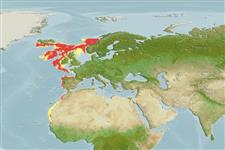Preferred temperature (Ref.
123201): 2.1 - 10.8, mean 7.1 °C (based on 138 cells).
Phylogenetic diversity index (Ref.
82804): PD
50 = 0.5000 [Uniqueness, from 0.5 = low to 2.0 = high].
Bayesian length-weight: a=0.00282 (0.00133 - 0.00596), b=3.25 (3.08 - 3.42), in cm total length, based on LWR estimates for this Genus-body shape (Ref.
93245).
Nível Trófico (Ref.
69278): 3.5 ±0.37 se; based on food items.
Resiliência (Ref.
120179): Baixo, tempo mínimo de duplicação da população 4,5 - 14 anos (Fec assumed to be <100).
Fishing Vulnerability (Ref.
59153): Very high vulnerability (90 of 100).
Nutrients (Ref.
124155): Calcium = 2.52 [0.35, 50.19] mg/100g; Iron = 0.251 [0.024, 3.283] mg/100g; Protein = 15.3 [13.2, 17.3] %; Omega3 = 0.371 [0.154, 0.920] g/100g; Selenium = 23.3 [4.1, 104.2] μg/100g; VitaminA = 2.81 [0.20, 39.61] μg/100g; Zinc = 0.241 [0.016, 2.910] mg/100g (wet weight);
